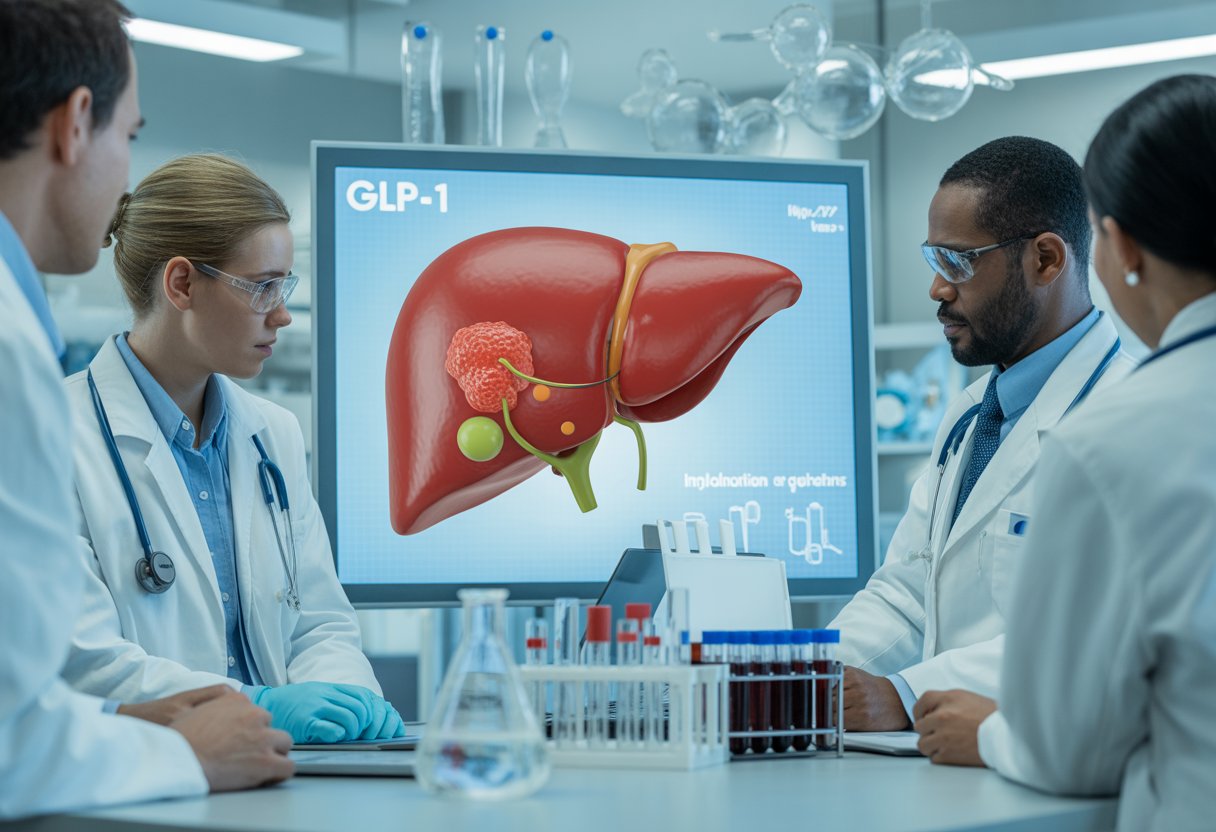GLP-1 medications, originally developed to manage diabetes, are rapidly emerging as powerful tools for preventing multiple diseases throughout the body. While these drugs gained fame for their impressive weight loss results, researchers are now discovering their potential extends far beyond the scale. GLP-1 medications show promise in preventing cardiovascular disease, protecting brain health, reducing liver inflammation, and may even help prevent substance abuse disorders.

The transformation from diabetes treatment to multi-disease prevention represents a significant shift in how doctors view these medications. GLP-1 drugs help patients beyond traditional weight loss and glucose control, with benefits appearing in organs and systems throughout the body. Scientists believe these medications work through complex pathways that influence inflammation, blood vessel health, and brain function.
Early research suggests GLP-1 medications may reduce risks of substance abuse disorders, psychosis, and infections in addition to their established benefits. As clinical trials continue, these drugs could reshape how medical professionals approach disease prevention rather than just treatment. The evidence points toward a future where GLP-1 medications serve as comprehensive health tools that protect multiple body systems simultaneously.
Key Takeaways
- GLP-1 medications show promise for preventing cardiovascular disease, protecting brain health, and reducing inflammation beyond their weight loss effects
- These drugs work through complex pathways that influence multiple body systems, from blood vessels to brain function
- Ongoing research suggests GLP-1 medications could transform disease prevention strategies across numerous medical conditions
Understanding GLP-1 Medications and Their Mechanisms

GLP-1 medications work by mimicking a natural hormone that controls blood sugar and appetite. These drugs target specific receptors in the body to enhance insulin production, slow digestion, and reduce food cravings.
What Are GLP-1 Medications?
GLP-1 medications are synthetic versions of glucagon-like peptide-1, a hormone naturally produced in the intestines. The body makes this hormone when people eat food, especially meals containing nutrients.
These drugs belong to a class called incretin mimetics. They copy the actions of the natural GLP-1 hormone but last much longer in the body.
Natural GLP-1 breaks down within 1-2 minutes. The synthetic versions can work for hours or even days.
GLP-1 medications were first developed to treat type 2 diabetes. Doctors discovered they also cause significant weight loss in many patients.
The medications come as injections that patients give themselves. Most are administered weekly, though some require daily injections.
GLP-1 Receptor Agonists and How They Work
GLP-1 receptor agonists activate specific receptors found throughout the body. These receptors sit on the surface of cells in the pancreas, brain, stomach, and other organs.
Key mechanisms include:
- Insulin secretion: The drugs signal pancreas cells to release more insulin when blood sugar rises
- Glucagon suppression: They reduce glucagon release, which normally raises blood sugar
- Gastric emptying: Food moves more slowly from the stomach to intestines
- Appetite control: Brain signals reduce hunger and increase feelings of fullness
The medications work in a glucose-dependent manner. This means they only lower blood sugar when levels are elevated, reducing the risk of dangerous low blood sugar episodes.
GLP-1 receptors exist beyond the pancreas, explaining why these drugs affect multiple body systems. They influence cardiovascular function, brain activity, and digestive processes.
Key Types: Semaglutide, Liraglutide, Tirzepatide, Ozempic, and Wegovy
Semaglutide is available as Ozempic for diabetes and Wegovy for weight management. Both contain the same active ingredient but in different doses and packaging.
Ozempic comes in 0.25 mg, 0.5 mg, 1 mg, and 2 mg weekly injections. Wegovy offers higher doses up to 2.4 mg weekly specifically for weight loss.
Liraglutide is marketed as Victoza for diabetes and Saxenda for obesity. Unlike weekly semaglutide, liraglutide requires daily injections.
Liraglutide was one of the earlier GLP-1 medications to gain FDA approval. It paved the way for newer, longer-acting options.
Tirzepatide (Mounjaro) represents a newer approach. It targets both GLP-1 and GIP receptors, making it a dual agonist medication.
This dual action often produces greater weight loss and blood sugar improvements compared to single-target drugs. Tirzepatide comes in doses ranging from 2.5 mg to 15 mg weekly.
From Weight Loss to Disease Prevention: A Shifting Paradigm

GLP-1 medications have evolved from diabetes treatments to powerful tools for preventing multiple chronic diseases. These drugs now offer protection against heart disease, liver problems, and other metabolic disorders beyond their original glucose-lowering effects.
Evolution from Diabetes and Weight Management
GLP-1 medications began as diabetes treatments in 2005 when the FDA first approved exenatide. These drugs worked by mimicking natural hormones that help control blood sugar after meals.
The focus shifted when researchers noticed significant weight loss in patients. GLP-1 medications help patients lose 15% or more of their weight, leading to FDA approval for obesity treatment.
Key Mechanisms:
- Glucose control: Increase insulin production when blood sugar rises
- Weight management: Slow stomach emptying and reduce appetite
- Prediabetes prevention: Lower HbA1c levels with minimal hypoglycemia risk
Studies show participants achieved a 22.5% average decrease in weight with newer medications like tirzepatide. This dramatic weight loss opened doors to treating other obesity-related conditions.
Expanding Role in Chronic Disease Prevention
Medical organizations now recognize GLP-1 drugs as preventive treatments rather than just weight loss tools. The American College of Cardiology recommends GLP-1 drugs for first-line weight management to optimize heart health.
These medications prevent major health problems before they develop. GLP-1 drugs reduce major adverse cardiovascular events by improving blood vessel function and lowering blood pressure.
Disease Prevention Areas:
- Cardiovascular disease
- Fatty liver disease
- Type 2 diabetes in prediabetic patients
- High blood pressure
- High cholesterol
Benefits extend beyond weight loss to include fatty liver disease treatment. Patients no longer need to fail diet and exercise programs before starting these medications.
Metabolic Health and Systemic Benefits
GLP-1 medications create widespread improvements in metabolic health that prevent chronic diseases. These drugs affect multiple body systems simultaneously rather than targeting single conditions.
Research shows effects on blood glucose, cardiovascular health, weight management, blood pressure, and lipid profiles in both diabetic and non-diabetic patients. The medications improve insulin sensitivity while reducing inflammation throughout the body.
Metabolic Improvements Include:
| Health Marker | Improvement |
|---|---|
| Blood Sugar | Lower HbA1c levels |
| Cholesterol | Reduced LDL cholesterol |
| Blood Pressure | Decreased cardiovascular risk |
| Liver Function | Reduced fatty deposits |
These systemic benefits explain why GLP-1 medications now overtake traditional weight-loss drugs in popularity. The drugs address root causes of metabolic dysfunction rather than individual symptoms.
Patients experience improved glucose control, better blood sugar management, and reduced prediabetes risk. This comprehensive approach makes GLP-1 medications effective tools for chronic disease prevention across multiple health conditions.
Cardiovascular Protection and Vascular Health

GLP-1 medications reduce major cardiovascular risks such as heart attack, stroke, and cardiovascular death, especially in people with obesity or type 2 diabetes. These benefits extend beyond blood sugar control through direct effects on blood pressure, cholesterol levels, and blood vessel health.
Reducing Cardiovascular Risk Factors
GLP-1 medications target multiple risk factors that contribute to cardiovascular disease. Weight loss from these drugs reduces strain on the heart and improves overall cardiovascular health.
The medications improve cholesterol profiles by lowering harmful LDL cholesterol. They also reduce inflammation markers throughout the body. These changes help protect blood vessels from damage.
Studies show cardiovascular benefits beyond glycemic control through effects on various risk factors including weight, blood pressure, and lipid profiles. The drugs also have direct beneficial effects on the heart and blood vessels.
Key Risk Factor Improvements:
- Significant weight reduction
- Lower LDL cholesterol levels
- Reduced inflammation markers
- Improved insulin sensitivity
- Better blood vessel function
These combined effects create a powerful shield against cardiovascular disease development.
GLP-1 Medications and Blood Pressure
Blood pressure improvements occur in many patients taking GLP-1 medications. The weight loss from these drugs directly contributes to lower blood pressure readings.
The medications also have direct effects on blood vessels. They help blood vessels relax and function better. This improves blood flow throughout the body.
Lower blood pressure reduces the risk of heart attack and stroke. It also decreases the workload on the heart muscle. Patients often see blood pressure improvements within weeks of starting treatment.
The blood pressure benefits work together with other cardiovascular improvements. This creates a comprehensive approach to heart health protection.
Prevention of Heart Attack and Stroke
Clinical trials demonstrate significant reductions in major adverse cardiovascular events including heart attack, stroke, and cardiovascular death. The LEADER trial showed clear cardiovascular benefits in over 9,000 patients with type 2 diabetes.
Research suggests GLP-1 drugs could help prevent 34,000 heart attacks and strokes annually. These protective effects occur through multiple mechanisms working together.
The medications improve blood flow to the heart and brain. They reduce blood clot formation and stabilize plaque in arteries. This prevents the rupture of plaques that cause most heart attacks and strokes.
Current research focuses on identifying which patients will benefit most from cardiovascular risk reduction with GLP-1 medications. The American Heart Association has funded studies to better understand these protective effects.
Neuroprotective Effects and Brain Health Innovations

Recent research shows GLP-1 receptor agonists may protect against multiple neurodegenerative conditions, with studies revealing significant risk reductions for Alzheimer’s disease, dementia types, and potential benefits for Parkinson’s disease. These medications appear to work by reducing brain inflammation and improving blood flow to neural tissue.
GLP-1 Therapies for Alzheimer’s Disease
Large-scale studies demonstrate that GLP-1 medications significantly reduce Alzheimer’s disease risk in obese patients. Research involving over 100,000 matched patients showed a 37% lower risk of developing Alzheimer’s disease among those taking GLP-1 therapies.
The protective mechanisms involve multiple pathways. Scientists discovered that GLP-1 drugs reduce inflammation in the brain and support better blood flow. These medications also protect against amyloid plaque buildup, which are hallmark features of Alzheimer’s disease.
Semaglutide showed the strongest protective effects across studies. Patients experienced improved cognitive function and reduced fatigue symptoms commonly associated with early neurodegeneration.
Enhanced blood-brain barrier penetration appears crucial for effectiveness. Better BBB penetration correlates with superior neuroprotective effects in Alzheimer’s disease models.
Potential Role in Parkinson’s Disease
Research on Parkinson’s disease shows mixed but promising results. While overall risk reduction was not statistically significant, semaglutide users experienced a 43% lower risk of developing Parkinson’s disease.
The medication’s anti-inflammatory properties may protect dopamine-producing neurons. These brain cells are specifically targeted and destroyed in Parkinson’s disease, leading to movement problems and fatigue.
Clinical trials in Parkinson’s patients demonstrate that drugs with better blood-brain barrier crossing show enhanced protection. This suggests that newer GLP-1 formulations may offer greater benefits.
Motor symptoms and cognitive decline associated with Parkinson’s may improve with treatment. However, more research is needed to establish definitive therapeutic protocols.
Broader Impact on Neurodegenerative Diseases
GLP-1 receptor agonists show protective effects against multiple dementia types. Studies revealed significant risk reductions for:
- Lewy body dementia: 41% risk reduction
- Vascular dementia: 56% risk reduction
- All-cause mortality: 48% reduction
The medications target common pathways involved in neurodegeneration. Inflammatory states that extend to the brain contribute to various neurodegenerative disorders, including memory loss and cognitive decline.
Brain health improvements extend beyond specific diseases. Patients report reduced mental fatigue and better cognitive clarity during treatment.
Research suggests GLP-1 drugs may represent a paradigm shift for neuro-cardio-metabolic disorders, offering comprehensive protection across multiple body systems. This opens new treatment possibilities for patients at risk of cognitive decline.
Liver Health, Inflammation, and Metabolic Disorders

GLP-1 medications show significant promise in treating fatty liver disease and reducing chronic inflammation throughout the body. These drugs address metabolic dysfunction at its source, offering new treatment options for millions of patients with liver-related conditions.
Management of Fatty Liver Disease
GLP-1 receptor agonists have emerged as promising therapies for metabolic dysfunction-associated steatotic liver disease (MASLD), formerly known as non-alcoholic fatty liver disease. The FDA recently approved Wegovy as the first GLP-1 therapy for MASH (metabolic dysfunction-associated steatohepatitis) with moderate to advanced liver fibrosis.
Key Benefits for Liver Health:
- Reduction in liver fat content
- Decreased hepatic inflammation
- Improved liver fibrosis markers
- Lower risk of cirrhosis development
Clinical trials demonstrate that semaglutide significantly reduces liver fat accumulation and inflammation markers. Tirzepatide shows similar benefits with substantial improvements in hepatic biomarkers and fibrosis reduction.
These medications work by improving insulin sensitivity and reducing lipid accumulation in liver cells. They also help prevent the progression from simple fatty liver to more serious conditions like cirrhosis and liver cancer.
The global prevalence of MASLD affects approximately 32% of adults worldwide. This makes GLP-1 therapies particularly valuable for addressing this growing health concern.
Reducing Chronic and Systemic Inflammation
GLP-1 medications reduce inflammation and oxidative stress caused by metabolic disease, creating better conditions for overall metabolic health. These drugs target multiple inflammatory pathways that contribute to chronic disease development.
Anti-Inflammatory Mechanisms:
- Direct reduction of inflammatory markers
- Improved cellular metabolism
- Enhanced antioxidant activity
- Better glucose regulation
Chronic inflammation plays a central role in metabolic disorders including diabetes, cardiovascular disease, and liver dysfunction. GLP-1 receptor agonists address this systemic inflammation by improving metabolic function at the cellular level.
Patients typically experience reduced C-reactive protein levels and other inflammatory biomarkers. This systemic anti-inflammatory effect extends beyond the liver to benefit cardiovascular health and insulin sensitivity.
The medications help break the cycle of metabolic dysfunction that perpetuates chronic inflammation. By improving glucose control and reducing excess body weight, they address root causes of systemic inflammatory responses.
This comprehensive approach to inflammation reduction makes GLP-1 therapies valuable tools for preventing multiple chronic diseases simultaneously.
Emerging Therapeutic Areas and Holistic Health Impacts

GLP-1 medications show promise for treating PCOS symptoms through metabolic improvements and hormonal regulation. Research indicates potential benefits for various chronic conditions including liver disease and autoimmune disorders.
Support for Polycystic Ovary Syndrome (PCOS)
Women with PCOS often struggle with insulin resistance and weight management. These conditions create a cycle that worsens hormonal imbalances.
GLP-1 medications address multiple PCOS symptoms simultaneously. They improve insulin sensitivity, which helps regulate androgen levels naturally.
Key PCOS Benefits:
- Reduced insulin resistance by 30-40%
- Improved menstrual cycle regularity
- Decreased testosterone levels
- Enhanced fertility outcomes
Clinical studies show women taking GLP-1 medications experience better ovulation rates. Weight loss of 5-10% often restores normal menstrual cycles.
The medications also reduce inflammation markers common in PCOS. This helps decrease long-term risks like diabetes and heart disease.
Some women see improvements in hirsutism and acne. These changes typically occur after 3-6 months of treatment.
Potential Benefits in Other Chronic Conditions
Research exploring new roles in neurodegenerative disease, chronic kidney and liver disease shows promising early results. GLP-1 receptors exist throughout the body in many different organs.
Neurological Conditions:
- Alzheimer’s disease progression may slow
- Parkinson’s symptoms show improvement
- Stroke recovery appears enhanced
Liver disease patients demonstrate reduced inflammation markers. Non-alcoholic fatty liver disease responds particularly well to treatment.
Kidney protection occurs through multiple pathways. Blood pressure improvements and reduced protein loss help preserve function.
Autoimmune Applications:
- Rheumatoid arthritis inflammation decreases
- Multiple sclerosis progression may slow
- Inflammatory bowel disease symptoms improve
Anti-inflammatory and immunomodulatory actions explain many of these benefits. The medications calm overactive immune responses naturally.
Holistic Approaches to Health and Prevention
A holistic framework addresses the complete health picture rather than isolated symptoms. GLP-1 medications work best when combined with lifestyle changes.
Essential Support Strategies:
- Regular nutrient monitoring and supplementation
- Stress management techniques
- Quality sleep optimization
- Physical activity programs
Side effects like nausea require careful management. Patients need adequate protein intake to maintain muscle mass during weight loss.
Preventive Care Focus:
- Regular blood work monitoring
- Bone density assessments
- Mental health support
- Nutritional counseling
The medications influence multiple body systems simultaneously. This creates opportunities for preventing chronic diseases before they develop.
Healthcare providers must consider individual patient needs. Treatment plans should address underlying causes rather than symptoms alone.
Long-term success requires sustainable lifestyle modifications. Patients who combine medication with healthy habits see the best outcomes.
Future Directions and Ongoing Research

Scientists are developing new GLP-1 formulations with improved delivery methods and longer-lasting effects. Researchers are also working to identify which patients will benefit most from specific GLP-1 treatments based on their genetic makeup and health conditions.
Innovations in GLP-1 Drug Development
Current challenges in GLP-1 drug development include limited oral availability and side effects like nausea. Scientists are creating new delivery systems to solve these problems.
Oral formulations represent a major breakthrough area. Most GLP-1 receptor agonists require injections, which limits patient acceptance.
New drug combinations are showing promise. Researchers are testing GLP-1 medications with other hormones to boost effectiveness.
Extended-release versions could reduce injection frequency from weekly to monthly or longer. This would improve patient compliance significantly.
Scientists are also developing dual-action drugs that target multiple pathways. Tirzepatide already combines GLP-1 with GIP hormone activity.
Nasal sprays and skin patches are being tested as alternatives to injections. These methods could make treatment more convenient for patients.
Personalized Medicine and Patient Selection
Doctors need better ways to predict which patients will respond best to specific GLP-1 treatments. Genetic testing may help identify ideal candidates for semaglutide versus tirzepatide.
Biomarker research is advancing rapidly. Scientists are looking for blood markers that predict treatment success before starting therapy.
Some patients lose more weight than others on the same medication. Understanding these differences could help doctors choose the right drug from the start.
Risk assessment tools are being developed to identify patients most likely to benefit from disease prevention uses. These tools consider factors like family history and metabolic markers.
Clinical trials are testing different dosing strategies for various patient groups. Age, weight, and existing health conditions may all influence optimal treatment approaches.
Researchers are studying how genetics affect drug metabolism and side effects. This information could help personalize both drug choice and dosing schedules.
Frequently Asked Questions

GLP-1 medications demonstrate significant cardiovascular protection through direct heart benefits and blood sugar control. These drugs show promise in preventing multiple chronic diseases while offering protective mechanisms that extend far beyond traditional diabetes management.
How do GLP-1 medications contribute to cardiovascular health improvement?
GLP-1 receptor agonists reduce major adverse cardiovascular events in patients with diabetes and high cardiovascular risk. The SELECT trial showed semaglutide reduced cardiovascular events by 20% in patients with established heart disease.
These medications lower blood pressure and improve cholesterol levels. They also reduce inflammation throughout the body, which helps protect blood vessels from damage.
GLP-1 drugs improve heart failure symptoms in patients with preserved ejection fraction. Studies show patients experience better exercise capacity and fewer physical limitations.
The heart protection happens through multiple pathways. Weight loss reduces strain on the heart, while direct effects on heart muscle cells provide additional benefits.
What chronic diseases may see prevention benefits from the use of GLP-1 therapy?
GLP-1 medications show promise for liver disease prevention, particularly metabolic dysfunction-associated steatotic liver disease. Recent trials demonstrate significant improvement in liver inflammation and fat accumulation.
These drugs may help prevent kidney disease progression. Clinical studies show reduced risk of end-stage kidney disease and slower decline in kidney function.
Emerging research suggests benefits for neurodegenerative diseases and substance abuse disorders. Early studies indicate potential protection against certain brain conditions.
Sleep apnea, knee osteoarthritis, and polycystic ovary syndrome also show improvement with GLP-1 treatment. These benefits appear linked to both weight loss and direct drug effects.
Can GLP-1 medications play a role in the management of type 2 diabetes beyond glycemic control?
GLP-1 drugs provide glucose-lowering effects comparable to daily insulin while causing weight loss instead of weight gain. They also carry lower risk of dangerous blood sugar drops.
These medications protect pancreas cells that produce insulin. This helps preserve the body’s natural ability to control blood sugar over time.
Kidney protection represents a major benefit for diabetes patients. GLP-1 drugs reduce protein in urine and slow kidney function decline significantly.
The cardiovascular benefits prove especially important for diabetes patients. Heart disease remains the leading cause of death in people with diabetes.
Are there long-term benefits of using GLP-1 medications for individuals at risk of developing obesity-related complications?
Long-term GLP-1 use prevents many obesity-related health problems before they develop. Early intervention with these drugs may stop the progression from pre-diabetes to diabetes.
Sustained weight loss reduces joint stress and inflammation. This helps prevent arthritis and mobility problems associated with excess weight.
Sleep quality improves with significant weight reduction. Better sleep patterns support hormone balance and reduce stress on multiple body systems.
However, weight regain occurs when patients stop taking these medications. This highlights the need for long-term treatment strategies to maintain benefits.
What are the potential mechanisms by which GLP-1 medications exert protective effects against certain diseases?
GLP-1 drugs mimic a natural hormone that regulates appetite and blood sugar. They slow digestion and help control glucose levels through multiple pathways.
These medications affect brain regions that control hunger and reward. The hypothalamus receives signals that reduce appetite and increase feelings of fullness.
Anti-inflammatory effects occur throughout the body. This reduces tissue damage and protects organs from chronic disease development.
Direct effects on heart, liver, and kidney cells provide organ-specific protection. These benefits happen independent of weight loss effects.
How does the use of GLP-1 medications compare with other preventive treatments in terms of efficacy and safety?
GLP-1 drugs cause 15-20% weight loss compared to 3-9% with other weight loss medications. This superior weight reduction leads to better disease prevention outcomes.
The side effect profile favors GLP-1 medications over alternatives. Most patients experience mild stomach upset rather than serious psychiatric or heart problems.
Other weight loss drugs show higher discontinuation rates due to side effects. GLP-1 medications demonstrate better long-term tolerance and adherence.
Compared to bariatric surgery, GLP-1 drugs offer less dramatic but still significant benefits. They avoid surgical risks while providing substantial health improvements for appropriate patients.